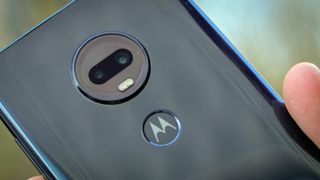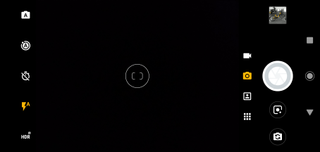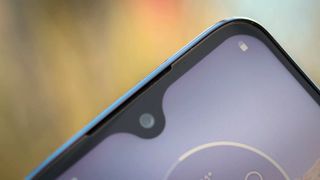Why you can trust TechRadar
Battery life
In terms of battery, the Moto G7 Plus comes with a reasonably-sized 3,000mAh power pack, but it's nowhere near as big as the monstrous 5,000mAh offering in the Moto G7 Power.
Crucially, it's also smaller than the 3,200mAh battery in the G6 Plus, but don’t let that put you off, the Moto G7 Plus still puts in a decent showing.
We comfortably got a full day of use (off charge at 7am, back on charge at 11pm) with double digits still left in the tank. Our usage usually consisted of a couple of hours of Netflix, another hour or two of Spotify streaming, an hour of gaming and a mix of calls, texts and social media usage throughout the day.
It’s unlikely to see you much into a second day, a nightly charge is still required, but you shouldn’t worry about your phone dying as you dip into the evening.

While day-to-day usage is more than acceptable, if you decide to settle down and watch a movie or put some serious time into your favorite game, the battery in the Moto G7 Plus does drain noticeable faster.
Running our 90 minute, full HD battery test, where we ramp screen brightness up to 100% and have various accounts syncing over Wi-Fi in the background, the G7 Plus lost 22% of its charge. It’s not a terrible result, and matches the Moto G7 which lost the same amount, but it is out done by a number of rivals such as the Honor Play.
If you do find the battery getting low the Moto G7 Plus has an ace up its sleeve which no other G7 phone does; a 27W TurboPower charger.
The supported plug adapter is included in the box and Motorola claims that it can offer 12 hours of use after just 15 minutes of plugged-in time. That claim isn’t far off either, as during our 0% to 100% test the G7 Plus managed to regain over 40% of life in a quarter of an hour.
During our moderate to heavy usage that would get us to around 8-10 hours, which is still impressive, as is the less than an hour from empty to full recharge time. It really is fast charging.
Camera
The Moto G7 Plus camera is the best specced of all the G7 snappers, with a primary 16MP camera boasting an f/1.7 lens, optical image stabilization and a lot of shooting modes.
Picture quality is very impressive for the price. The higher pixel-count, when compared to the G7 and G7 Power’s 12MP cameras, means results visibly showcase more detail in good light, while the optical image stabilization delivers impressive low light performance and video quality at up to 4K.
It also delivers better dynamic range than the rest of the G7 series, and indeed most if not all phones at the price, though naturally, it isn’t Google Pixel 3 good, with no long exposure night mode, for example.

White balance is generally fair, but the phone sports very aggressive tap-to-expose metering, so you may have to dial up or down the exposure using the slider once you lock focus to get the best out of it.
Lower the lights, and results get a bit grainier and processing becomes visible, but it’s all significantly better than we expected it to be.
Motorola lets things get a little dark, and a little grainy, and that actually makes for a more natural looking, pleasing shot, though there are times when it leans towards exposing a little brighter than necessary, so once again, the exposure slider will be your best friend if you’re looking for perfection in your pictures.
Thanks to the 5MP secondary sensor coupled with an f/2.2 lens, artificial background blur in portrait mode is also accurate, and there’s an additional mode - ‘cutout’ - that totally separates a foreground object and lets you apply a background of your choice.

You can pre-adjust the level of blur, allowing you to see live what your shot will look like before hitting the shutter key. It’s a nice feature and makes using portrait mode more engaging.
We found the Moto G7 Plus produced solid portrait shots, with our subject nicely defined against the blurred background.
Zoom in on an image and you will notice some bleeding of the blur effect, especially around less defined edges such as hair, but considering the price point it’s more than acceptable.
The Moto G7 Plus comes with more camera modes too, including spot color and cinemagraph. Spot color is a fun option, allowing you to select one color in your image to focus on, while turning the rest of the shot to black and white.
We found some patience was needed to get the correct color highlighted, and there were times when the G7 Plus wasn’t able to fully detect the entirety of a color on a surface resulting in odd-looking photos.
When shooting video at up to 4K video, there’s electronic image stabilization to complement OIS, and it does a great job, despite applying a heavy crop factor.
What’s excellent is the fact Motorola lets you turn stabilization off, getting rid of the crop - perfect for tripod shooting when you want the full view in frame.
Low light performance in video is good, not great, so if you can, keep it locked to daylight and well-lit conditions, you’ll get excellent results.

As for selfies, the 12MP front camera grabs a decent amount of detail, and you can use the screen as a fill flash to brighten things up and even things out.
For the price, the Moto G7 Plus’ camera is excellent for novices and pros alike, especially when you factor in the shooting modes we haven’t mentioned, ranging from a spot color picker (which worked well 80% of the time) to full manual mode.
Camera samples







Current page: Battery life and camera
Prev Page Price, design and display Next Page What's it like to use?
John joined TechRadar over a decade ago as Staff Writer for Phones, and over the years has built up a vast knowledge of the tech industry. He's interviewed CEOs from some of the world's biggest tech firms, visited their HQs and has appeared on live TV and radio, including Sky News, BBC News, BBC World News, Al Jazeera, LBC and BBC Radio 4. Originally specializing in phones, tablets and wearables, John is now TechRadar's resident automotive expert, reviewing the latest and greatest EVs and PHEVs on the market. John also looks after the day-to-day running of the site.
